
Exchange-種を植える
2013年10月26日(土)~12月15日(日)
air2013-3ja
久門 剛史
HISAKADO Tsuyoshi
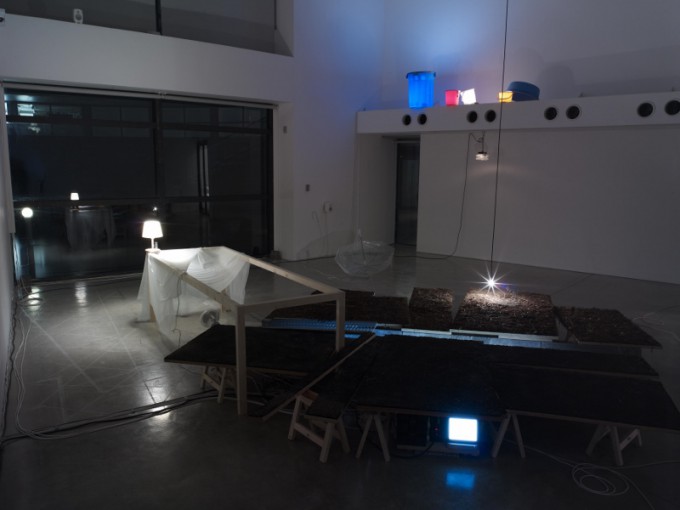
《ハレかケ。―青森―》 撮影:山本糾
日常の並行世界を生む舞台/彫刻
服部浩之
展示室中央に置かれたコンクリート側溝を中心として、入り口から見て側溝の手前側には土が盛られた厚手の合板が並べられ、逆側にはアスファルトを固めた合板が設置されている。土のうえにはガラス板の時計が載せられ、一部グレーチングが填められた側溝内に据えられた蛍光灯は、明滅を繰り返している。アスファルト板に片脚が乗るかたちでベッドを思わせるフォルムの木材のフレームが組まれ、そこには白い薄手のカーテンが半分くらい被せられ、片隅に卓上ライトが置かれている。その足元には小さな扇風機が見える。さらに手前の脇にはひっくり返されて少しだけ水が溜まったビニル傘が放るように設置され、すぐ上の換気ダクト上部にはバケツやたらいがいくつか載せられている。そのさらに手前には床上に壁に立てかけるかたちで昔ながらの電話の受話器が置かれている。あとは白いコンパクトなスピーカーが数個壁面などに設置され、たくさんの配線が無造作に、でもすっきりとまとめられて床上を這っている。その他にこの空間にあるのはアスファルト板の下に据えられた小さなモニタといくつかの機材くらいだ(fig.1)。そして作者の久門剛史は彫刻学科出身である。
この情報のみからだと、日常品を用いた彫刻かインスタレーションというのが最初に想像されるだろう。確かに形式的にはまさしくその通りなのだが、実際にこの作品を経験すると、それはむしろ舞台作品のように感じられる。一見無造作にレイアウトされたこれらの日常生活で目にするモノたちは、なんらかの動作を生じるように、コンピュータプログラミングにより制御されている。室内に入ると、まず何かしら音が耳に入る。子供の声、電話の鳴る音、時報の音、雨の音など。時には傘のなかで水がブクブクとたてる音がきこえ、あるいは扇風機が静かにまわる音がきこえるなど、様々な音があるときは静かに、あるときは大音量でランダムに響く。しばらくこの空間にいると、側溝内の蛍光灯や卓上ライト、またはバケツのなかの電球や、天井に吊られた円形の蛍光灯など、明滅するすべての光は、音をシグナルとしてスイッチがon/offされる仕組みになっていることに気付く。音が聴こえ、明かりが点灯する。そして風が吹き、カーテンが揺れ、水がざわめく。極めて当たり前のどこにでもある現象が無作為に繰り返される。書き出すと、普通でそっけないものに思われるだろう。しかし、この無造作な物質の配置と、それらが引き起こす単純明解な現象のみで、久門はとても豊かなインタラクションを生み出している。
少しのんびりとこの作品空間を堪能してもらうと、およそ10分以内で一通りの音や光の現象がすべて起こっていることが確認できる。正確には用意された現象は6分50秒ですべて発生し、また同じ時間で繰り返される。それぞれの現象が起こるタイミングはある程度ランダムになるように、プログラムが組まれている。つまり、順列組合せになるので無限とは言えないかもしれないが、全く同じ流れの構成はまず二度と起こらないと言える。しかし用意されたすべての現象は、6分50秒以内に毎回漏れなく発生する。ある意味、録音された幾つかの音源を用いて構成される即興演奏を繰り返し聴く感覚に近い。興味深いのは、どの一サイクルを体験しても、そこには大きな差異がないことだ。光の点灯や、発せられる音声など、順番は入れ替われど、劇的な変化や、偶然の組み合わせによる意外性はほとんどない。むしろあるサイクルで繰り返されている印象が非常に強い。プログラミングにより偶然さえもコントロール下に置かれてしまうのだ。ほんの少しだけ異なる当たり前の現象が順番を入れ替えて連続される。それは、そのまま私たちの日常生活に置き換えられるだろう。同じ一日は二度と来ないが、毎日似たような日々が繰り返される。鴨長明が言うところの「行く川の流れは絶えずして、しかももとの水にあらず」(1) という境地を体現している作品だ。
日々の繰り返しに豊かさや飛躍を与えるものとして、予期せぬ人との出会いなどが挙げられる。この作品において最も大きな偶然を導くのが、作品を体験する観客の存在だろう。そこに人がいようがいまいが、電源を落とされるまで常に小さな差異を生みながらこの作品は繰り返される。ひとりで作品空間を体験しているときと、だれか別の人がいるときとでは、作品の様相は一変する。「観客同士の相互作用が起こるような場や空間をつくりたい」(2) と久門は述べており、まさにこれは作品自体が観客同士の関係を変容させるインターフェース的な役割も担うひとつの舞台でもあるのだ。観客はこの作品空間に入ったその瞬間から舞台に上げられていたことに、別の誰かが入ってくることで気付く。
ところで、作品タイトルは《ハレかケ。─青森─》という。ハレとケは、非日常と日常であり、この作品は様々な対照関係や二項対立により構成されていることが伺える。久門が「森林の中に建造された人工物としての印象を受けたACACの存在を発想の出発点とし、様々な境界とその相互関係を『ハレとケ』という日本特有の民俗学の考え方を基本として考えてみました」(3)と述べるように、人工的なアスファルトと土の大地が側溝を介して対照的に扱われ、そのまわりに現象を引き起こす事物が展開される。ひとつひとつの現象は極めて日常的でありふれたものだが、それらを組み合わせて音楽のように奏でることで、非日常の「ハレ」の経験を生み出す。繰り返される日常の断片を経験するなかで、この場所がハレの舞台に飛躍的に変換される瞬間が訪れるのだ。素早く繰り返される断片的な現象の集合は、人の感覚を徐々に鋭敏にしていき、いつのまにかハレの異世界へと導く。現象の反復により異次元の世界へと人を誘うのが久門の彫刻術と言えよう。
また、久門が制作したもう一点の《after that.》(fig.2)は、時計を取り付けた円形の鏡で球体を覆うミラーボールの作品で、時計の針にもすべて鏡が装着されている。モーターで回転するミラーボールには四方からLEDの青白いスポットライトが当てられ、その光を鏡が乱反射する。静寂のディスコとも呼べる空間では無数の時を刻む音が響き渡る。久門が「のび太たちが引き出しに入って時空を旅する感じにも見える」(4)と語るように、日常である机の引き出しからつながっている異次元世界を、鏡という私たちの日常を映し出す装置の特性(能力)を引き出すことで実現する。アニメ世界のようなフィクショナルな日常のパラレルワールドを、彼はその作品空間で生み出そうとしている。《ハレかケ。─青森─》は、プログラミングにより音や光を組み立てることで、非日常のハレの世界へと誘い、《after that.》では鏡により時間を乱反射させることで、異次元を生み出す。両者とも、日常生活にあふれる事物を、彫刻化という制御により飛躍した関係を生み出すことで、その裏にある並行世界としてのハレの舞台へと私たちの知覚を引き上げる行為だ。アニメなど現実とリンクする並行世界に浸ってきた世代らしい、日常の現象の起こり方をズラすだけで異世界を生み出す新しい彫刻術と言えるだろう。ありふれた現実的要素でつくられる非日常の美しい世界に溺れることで、私たちは再びこの日常を新鮮に知覚することができる。
(1) 鴨長明『方丈記』、岩波書店、1989年。
(2) 久門剛史へのインタビューより(2013年12月9日ACACにて。AC2 no.15掲載)
(3) 展覧会配布資料掲載の作家本人による解説より抜粋。
(4) 同上。

撮影:山本糾



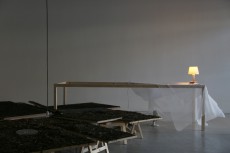
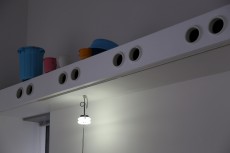
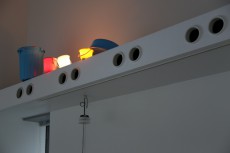
《ハレかケ。―青森―》(部分)撮影:久門剛史

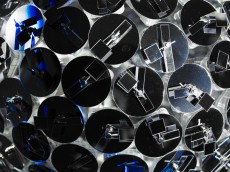
after that. 撮影:山本糾
Exchange ―Planting the seed
October 26 – December 15, 2013
HISAKADO Tsuyoshi
久門 剛史

HARE or KE --AOMORI-- photo: YAMAMOTO Tadasu
Stages or Sculptures to Create the Parallel World in Everyday Life
HATTORI Hiroyuki
A gutter made from concrete is installed in the center of the gallery, and heavy sheets of plywood covered with soil are placed on the near side of the gutter from the entrance, and then there is a sheet of asphalt plywood on the opposite side. A clock encased in glass has been put on the soil, and a fluorescent lamp installed in the gutter partly with gratings flashes on and off continuously. A wooden frame resembling the shape of a bed has one leg on the sheet of asphalt plywood, and a thin white-colored curtain covers almost half of the
flame, along with a desk lamp which stands in the corner. You also find a small electric fan near its legs. In addition to such things, a plastic umbrella is set upside down in a disorderly fashion, with water gathering inside, again near the entrance, and there are some buckets and basins on the top of the ventilation duct above the umbrella. A receiver from an old-fashioned telephone is leant against the wall much nearer to the entrance. Several compact white loudspeakers are also installed onto the wall, and lots of wires are running to the floor in a seemingly careless yet tidy way. The rest of the things in the gallery include a small monitor and some tools under the sheet of asphalt plywood (fig.1). The artist who created this artwork, HISAKADO Tsuyoshi, graduated from the department of sculpture at university.
Such information might at first remind you of sculpture or installation
using everyday necessities. It is certainly true by outward appearance, but once you experience this artwork you consider it to be a performance art. All the everyday items, seeming to be arranged carelessly, are under the control of computer programming in order to generate movement. On entering the gallery, you will initially hear some sounds, for example the voice of a child, a telephone ringing, time signal and the sound of rain. Sometimes you hear the sound of water bubbling in the umbrella and at other times the sound of the
electric fan revolving smoothly. These different sounds sometimes resonate faintly, or at other times very loudly and at random. When you stay in the gallery for a while, you will notice a system of switches blinking lights on and off at a given signal of sound; the fluorescent lamp installed in the gutter, the desk lamp, light bulbs in the buckets and a round fluorescent lamp hung from the ceiling. On hearing the sound, you see one of the lights on. And the wind blows, the curtain sways and the water murmurs. Such very ordinary and natural phenomena are happening over and over again randomly. Describing them in words makes you think them as normal or nothing special. However, Hisakado designs marvelously fertile interaction by means of randomly arranging objects to create a plain and simple phenomena.
If you take your time to walk around this art installation, you can find a series of phenomena of sounds and lights occuring approximately every 10 minutes. In precise terms all of the phenomena happens for the duration of 6 minutes and 50 seconds, and repeats for the same duration. Each phenomenon is programmed to happen at random to some extent. This means that completely the same composition never repeats, though there is some limitation in its permutations.
But all the phenomena happen within 6 minutes and 50 seconds without fail. In a sense, it seems like repeatedly listening to improvisation composed of several recorded sound sources. What is interesting is that there is not much difference among any cycle. Even if there are changes to the order of the blinking light, uttered voices and others, there is no surprise through dramatic changes and accidental composition. It gives the strong impression that a certain cycle of phenomena repeats. Even accidental happenings are also under the control of the programming. The cycle of ordinary phenomena changes each order slightly and happens repeatedly. That is also associated with our everyday life. We cannot live the same day, but similar days repeat over and over again. The artwork epitomizes what Kamo no Chomei remarked; the flowing river never stops and yet the water never stays the same(1).
What gives richness and a significant leap in the repetition of similar days is an encounter with an unexpected person. As for this artwork as well, the existence of audiences experiencing the artwork causes the most unexpected occurrence. Whether there is an audience or not, this artwork repeats the same thing, making continuous slight differences until the power off. But there is a significant difference in artwork between when you experience it alone and when view it with someone else. As Hisakado says, he wants to create a space to generate interaction amongst audiences(2), his artwork turns out to be a stage that plays a role like an interface in changing the relationship among audiences. When someone else comes in, you will find that you have stood on the stage since the moment you entered the gallery.
The title of this work is Hare or Ke -- Aomori --. “Hare and Ke” means
the extraordinary and ordinary, and so this artwork consists of a variety of contrasting relations and binomial confrontation. As Hisakado says his imagination was set off with existence of ACAC giving an impression as an artifact built in the forest, and he considered different borders and their mutual relations on the basis of a concept of Japanese unique folklore, “Hare and Ke”(3) , he contrasts artificial asphalt and soil with a gutter between them, which is surrounded by things to cause different phenomena. Each phenomenon is very ordinary and common, but by combining them into a kind of music generates extraordinary experience of “Hare”. Whilst experiencing fragments of everyday life in repetition, the moment comes that this place is dramatically converted to the stage of “Hare”. Senses of human beings become gradually apparent through the accumulation of rapidly repeating fragmental phenomena, which leads us unnoticeably to the parallel world of “Hare”. To invite us to another dimension by repetition of phenomena is Hisakado’s sculpture technique.
Another of his artworks titled after that. (fig.2) is a disco ball covered
with round mirrors to which clocks are attached, and on every clock hand there is a mirror attached . Bluish white spotlights of LED are directed from all quarters on the disco ball revolving with a motor, reflecting diffusely onto the mirrors. Countless sounds of the clocks ticking echo throughout the space called silent disco. As Hisakada says, it looks as if Nobita and his friends travel through space-time after entering a drawer of his desk (4), he incarnates another dimension linked with the drawer of everyday life, by bringing out the potential of a mirror that is an equipment designed to reflect our daily life. He attempts to create the fictional parallel world of everyday life, like an animated world, by means of his installation art. While the artist invites us to experience the extraordinary world of “Hare” through assembling sounds and lights by programming in the Hare or Ke --Aomori--, he creates another dimension through reflecting time via mirrors in the After That. Both artworks are considered as behaviour for pulling up our perception onto the stage of “Hare” or the parallel world, that is, a hidden side of everyday life, by generating extraordinary relations among everyday things using his sculpture technique. This new technique can create another world just by slightly changing the way daily phenomena happens, which is peculiar to the generation immersed in the parallel or animated world linked with reality. Becoming immersed in the extraordinary and beautiful world composed of ordinary and realistic elements enables us to perceive our daily life in a new and fresh manner.
(1) KAMO NO Chomei, 1989, Hojoki, Tokyo: Iwanami Shoten.
(2) Interview with HISAKADO Tsuyoshi in the Aomori Contemporary Art Centre on December 9, 2013. Published in AC2 no.15.
(3) Excerpted from artist’s explanation printed on a brochure distributed in the exhibition.
(4) Ibid.

photo: YAMAMOTO Tadasu






HARE or KE. --AOMORO-- (detail) photo: HISAKADO Tsuyoshi


after that. photo: YAMAMOTO Tadasu
